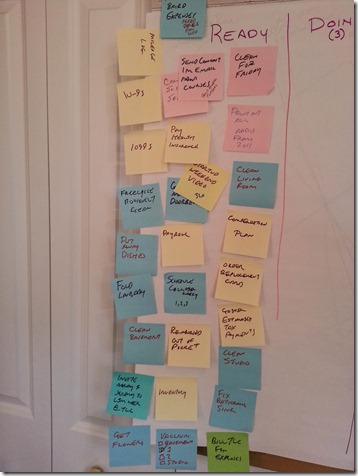When you look at your Personal Kanban, do you have tasks like “Do the Dishes” or are they more like “Build a House”?
If they’re more like the latter, ask yourself why.
Good Things Are Completed In Small Packages
Lean thinking asks us, in industry speak, reduce our batch sizes. This is their way of saying we should find tasks that can be completed quickly, effectively, and without many surprises.
We are more likely, whether at work or at home, to complete small tasks than large ones. Why?
They’re Small – First off, small tasks are simply that. They’re small. We can therefore complete them in less time.
They’re Understandable – Small tasks are easy to grasp. We can easily envision what needs to be done, how much uninterrupted time it should take, and what the end state will look like.
They are Stable – If a small task is something we can get done quickly, it means the chance of interruption is less and the potential number of complications is low. With most of our work, interruptions actually provide the most complication. That complication adds instability to our estimates.
They are not Scary – Large tasks, because we know full well that they are instable, are frightening. They evoke our fear response, making us procrastinate, making us spend more time planning how to mitigate risk, and distracting us while actually doing the work. Small tasks, because we understand them and they are stable are much less scary.
We are Confident – A small, stable, and understandable task is something we can promise to someone else and feel confident about the promise.
We can Knock Them Out – Think about how good a day feels when you move a lot of tickets off your Personal Kanban. Now, think of days where nothing moving. Sluggish movement on the Personal Kanban makes us feel sluggish as well.
Small Deliveries Make a Big Delivery
When we start a large project (and there certainly are large projects) we need to look at that project and figure out what the units of value are in it. Is this project something that has to be done all at once? Are there elements of this project that can be delivered quickly to provide value along the way? What do my customers really want from this project? What is the likelihood of interruptions causing me to shelve this project for long periods of time? Can I come back to this project and remember where I was?
If we can divide the project into smaller pieces of deliverable interim value, then we can can start enjoying some of the benefits of the big task – even if is has yet to be fully realized.
Say you have a big project that is: renovate the basement. This involves moving everything out of the basement, ripping out the walls, moving plumbing, putting in new walls, putting in floors, doing new electrical, painting, getting new furniture, and then enjoying the basement.
Many people look at that task and say, “That’s big, I’d like to do that, but I don’t have time.”
There are smaller tasks there, however. The first might be, “Go through basement and donate all unused or unwanted items.” (For some of us, even this is a big task). After that might come a task of “Get a new sofa” or even “Draw up basement plans”. Each of these provides immediate value and may well change the outcome for the larger project. Say you get rid of the clutter in the basement and find, lo and behold, there’s a lot more room down there now.
Now, instead of gutting the basement, you can do a few coats of paint, a few simple repairs, and you have a much more livable space.
Throughput of the Small
In my own life, I had a huge office with people working in it every day for 10 years. I also had a home studio where I had been both working and writing for 10 years. When I closed the office, I was left with 10 years of combined office and home paperwork and other junk.
I set aside a plan where each day I needed to take out one wastebasket worth of recycling. Over the course of a few months (I travel a lot), I was able to work my way through the mountain of combined personal, Modus, and Gray Hill history. If I had sat down and done that large task all in one sitting, it would have left me unable to write or work for clients. It would have been boring and, likely, I would have lost interest mid-way through and started just picking up huge piles of paper and shredding it without looking at it.
Using a small task throughput model like this, where I do a little a time, I could keep focus, work my way to completion, and not have to worry about the huge daunting task.










